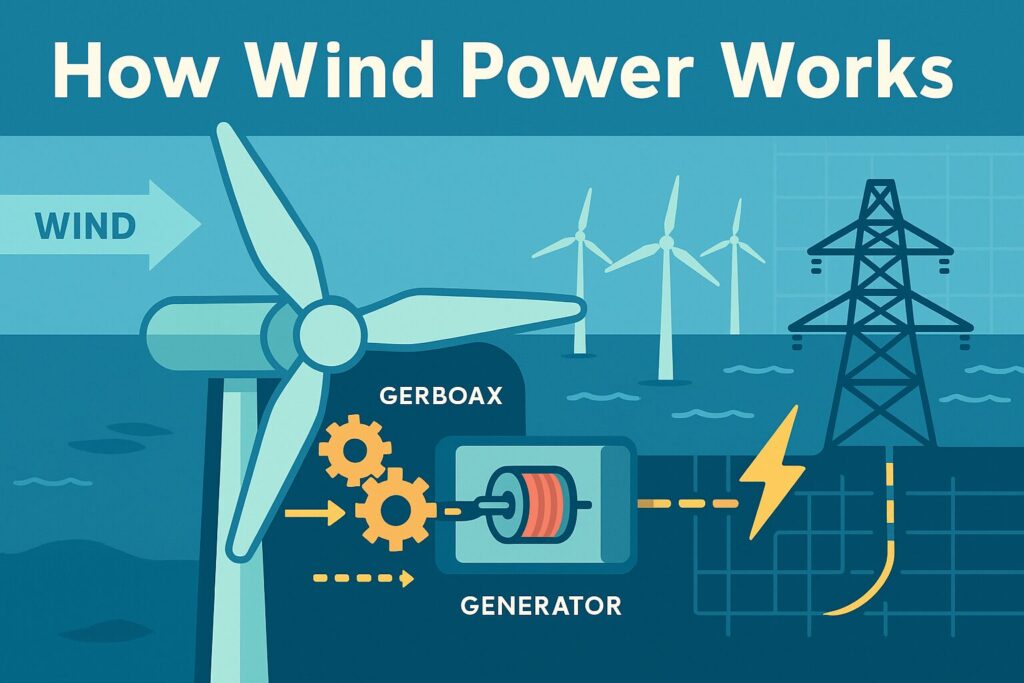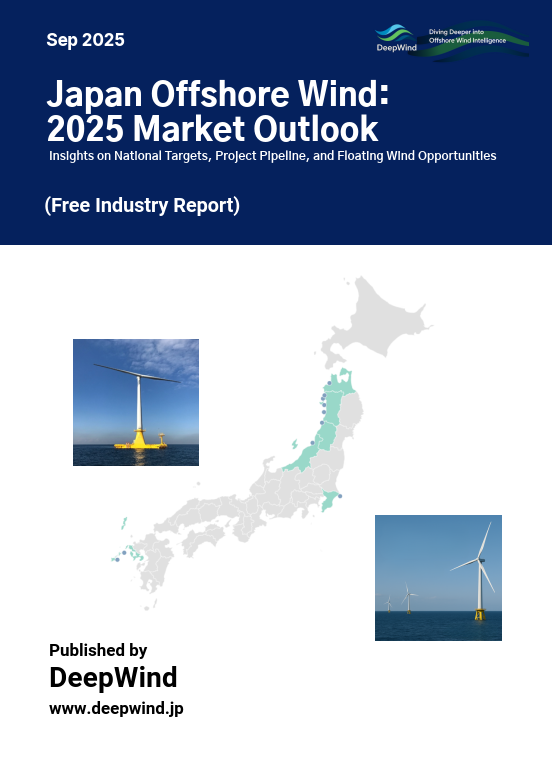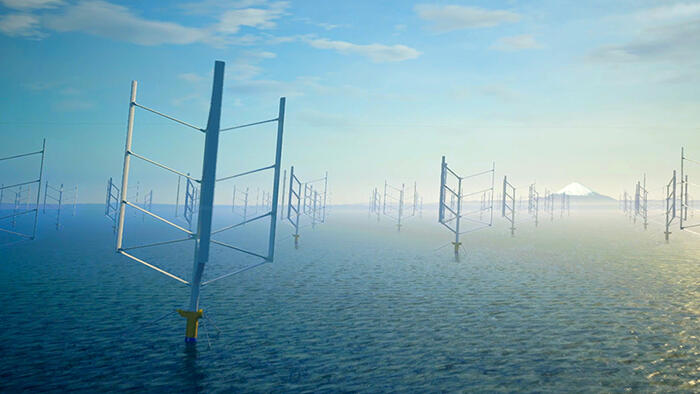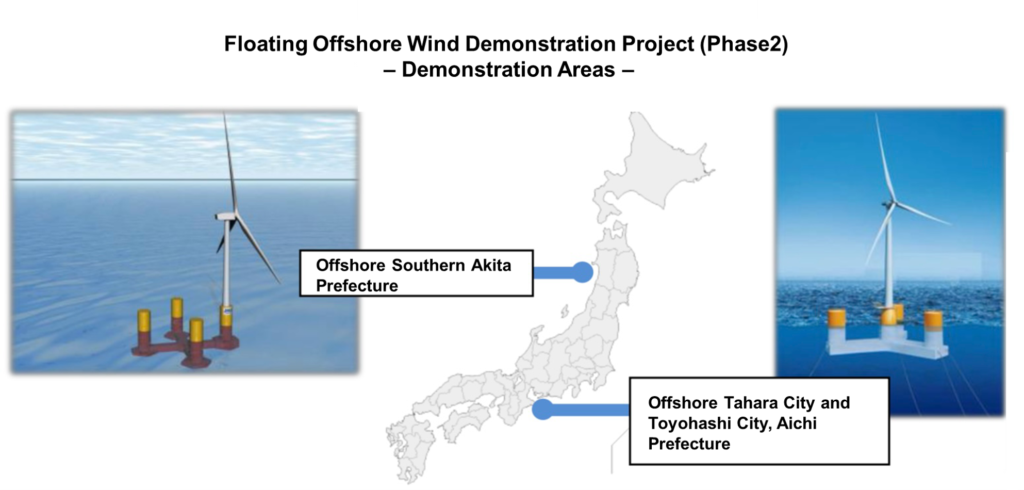Introduction
Rising concerns over climate change, dwindling fossil fuels, and volatile energy prices have shifted global focus toward renewable energy. Wind power, harnessing the freely available energy of the wind without CO₂ emissions or fuel costs, stands out as a sustainable, long-term solution. In Japan, wind power is rapidly expanding to help achieve the country’s 2050 carbon-neutral goal. This guide walks you through:
- The fundamentals of wind power
- Key turbine components and their roles
- Turbine types and installation methods
- Technologies for boosting efficiency
- Power transmission and grid integration
- Safety protocols and environmental safeguards
- Future trends, especially in offshore wind
This article takes a deep dive into this specific topic, but if you’re looking for a comprehensive overview of offshore wind technologies, check out our full summary article here:
👉 Offshore Wind Technology 2025: Foundations, Floating Wind, Turbines, and Innovations
1. Basic Structure & Mechanism
Wind turbines convert the kinetic energy of wind into electricity through a simple three-step process:
- Blade Rotation: Wind strikes the aerodynamic blades, causing them to spin.
- Speed Increase: The rotor’s slow rotation is transferred to a gearbox (or a direct-drive system) that ramps up the RPM.
- Power Generation: The high-speed shaft drives a generator where magnetic fields and coils interact to produce electricity.
Wind’s Cubic Law: Power output scales with the cube of wind speed (e.g., doubling wind speed yields eight times the power), making site selection with strong, consistent winds critical.

2. Main Components
A modern horizontal-axis wind turbine comprises:
- Blades: Usually three fiberglass-reinforced plastic (FRP) blades designed for optimal lift.
- Nacelle: Houses the gearbox, generator, and control electronics.
- Tower: Elevates the rotor to higher, steadier winds; tubular steel towers ranging 80–100 m tall are common.
- Foundation: Anchors the turbine—onshore uses concrete pads, offshore uses monopiles or jacket structures.
- Yaw & Pitch Systems:
- Yaw rotates the nacelle to face the wind.
- Pitch adjusts blade angle for maximum efficiency and storm protection.
3. Turbine Types & Installation Formats
By Rotor Orientation
- Horizontal-Axis (HAWT): The industry standard, offers high efficiency and scalability.
- Vertical-Axis (VAWT): Captures wind from any direction, suited for small-scale or urban installations.
By Location
- Onshore: Lower costs but faces land-use, noise, and visual impact issues.
- Offshore: Stronger, steadier winds allow for larger turbines; higher construction and transmission expenses.
Offshore Foundations
- Bottom-Fixed: Monopiles or jackets for shallow waters.
- Floating: Ideal for deep waters—four main types:
- Spar: Deep ballast for stability.
- Semi-Submersible: Lower center of gravity, reduced motion.
- Tension Leg Platform (TLP): Taut mooring lines minimize sway.
- Barge (Pontoon): Simple, cost-effective, suited for sheltered seas.
4. Efficiency-Enhancing Innovations
- Higher Towers: Reach faster winds above the boundary layer.
- Longer Blades: Increase swept area; advanced composites keep weight down.
- Advanced Pitch Control: Dynamically optimizes blade angle for safety and output.
- AI & Wind Forecasting: Leverages meteorological data and machine learning for optimal operation planning.
- Wake Loss Mitigation: Strategic turbine spacing to reduce downstream turbulence losses.
5. Transmission & Utilization of Generated Power
Wind-generated electricity follows this path to end users:
- Step-Up Transformers: Increase voltage at the turbine.
- High-Voltage Lines: Carry power to substations.
- Distribution Network: Voltages are stepped down for homes and businesses.
To manage wind’s variability, grid upgrades and ancillary systems are essential:
- Battery Energy Storage Systems (BESS): Store excess generation for later use.
- Demand Response: Consumers adjust usage to balance supply.
- Smart Grids: Real-time monitoring and control of the entire power network.
- High-Voltage Direct Current (HVDC): Minimizes losses over long distances.
6. Safety & Environmental Considerations
- Lightning Protection: Receptors and grounding protect nacelle and blades.
- Noise Control: Acoustic dampers, vibration isolation, and low-noise blade designs.
- Ecological Impact: Pre-installation environmental assessments; mitigation measures for marine life and bird migrations.
- Collision Avoidance: Radar-triggered shutdowns during high bird activity.
7. Future Outlook & Japan’s Prospects
Japan’s extensive EEZ and recent “Renewable Sea Area Utilization Act” reforms are accelerating offshore wind development. Advances in large floating turbines and streamlined installation methods promise cost reductions and stable supply. Wind energy’s growing role also supports local economies through supply-chain jobs and regional revitalization. Europe’s example—wind providing over 15 % of power in 2023—guides Japan’s target of 10 GW offshore capacity by 2030.
Conclusion
Wind power transforms a simple physical principle into a high-tech, integrated system spanning blades, gearboxes, control algorithms, and grid innovations. Understanding its mechanics, components, and challenges is key to promoting renewable energy adoption and achieving a carbon-neutral future.
For a broader look at offshore wind technologies and future innovations, make sure to explore our comprehensive summary article:
🌊 Offshore Wind Technology 2025: Foundations, Floating Wind, Turbines, and Innovations
Explore more categories at DeepWind:
- 🔍Market Insights – Understand the latest trends and key topics in Japan’s offshore wind market
- 🏛️Policy & Regulations – Explore Japan’s legal frameworks, auction systems, and designated promotion zones.
- 🌊Projects – Get an overview of offshore wind projects across Japan’s coastal regions.
- 🛠️Technology & Innovation – Discover the latest technologies and innovations shaping Japan’s offshore wind sector.
- 💡Cost Analysis – Dive into Japan-specific LCOE insights and offshore wind cost structures.



